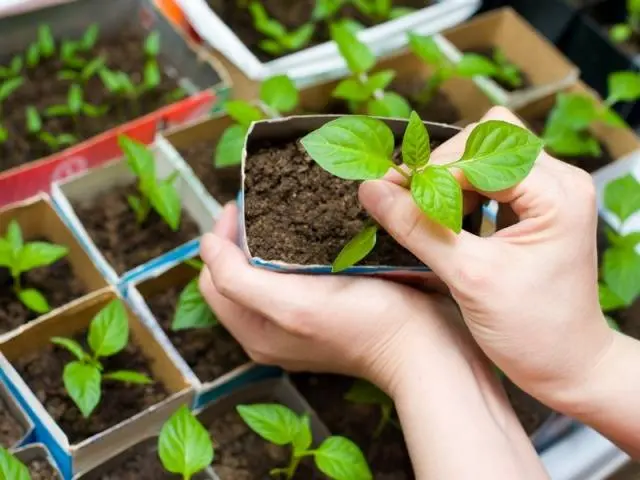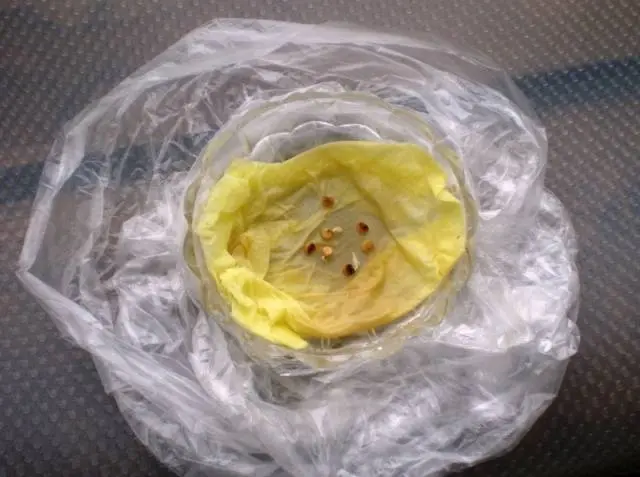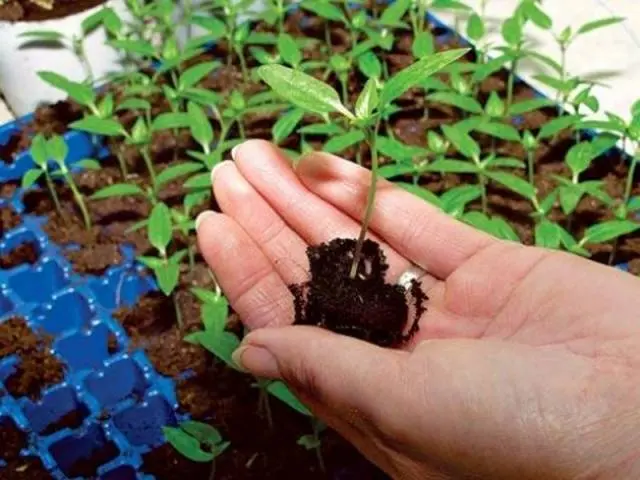Contents
Sweet peppers began to be grown in Europe 500 years ago. Since then, the number of varieties of this crop has increased several times – today more than two thousand varieties of sweet, or as it is also called, bell peppers are known. The love of gardeners for this culture of the nightshade family is quite justified, because the fruits of pepper contain the maximum amount of vitamins and useful trace elements, this is a real vitamin cocktail.
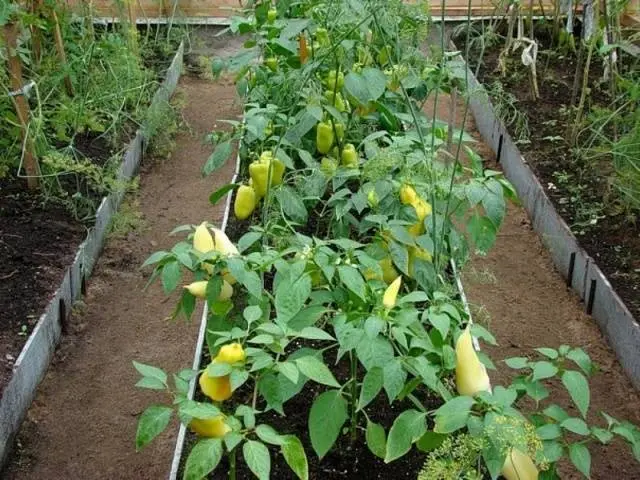
Bulgarian pepper is a heat-loving and rather capricious plant. On the territory of Our Country, it is planted with seedlings, and we will learn from this article how to grow bell pepper seedlings, how to properly care for pepper seedlings.
How to grow good pepper seedlings
To get high yields, first of all, you need to plant strong and healthy seedlings on the beds or in greenhouses. Such a delicate culture as bell pepper has its own characteristics that every gardener should know about:
- Pepper does not like too frequent watering – the land between the rows should not dry out, but should not be too wet either.
- The soil between the rows must be loosened to a depth of about five centimeters, it is recommended to do this before each watering.
- Leaves of plants will tell about the lack of minerals or fertilizer – they curl, change color, dry out or are dropped from the bushes.
- Most varieties of bell peppers are pollinated crops, so the gardener must take care to attract bees or other pollinating insects to the plot or greenhouse.

- Excessive soil moisture is signaled by a specific disease of bell pepper – a black leg, which is easy to recognize by the decaying lower part of the stem.
- Peppers, unlike tomatoes, do not need to be pinched – thick lower leaves are designed to protect the soil under the bush from excessive drying out. Stepsons should be removed only if the summer turned out to be too hot and humid at the same time – this will protect the plants from decay and contribute to better ventilation of the bushes.
- The culture has a very delicate root system, so it does not tolerate picking and transplanting. Growing seedlings of pepper is best done in disposable peat cups, which are planted in holes along with seedlings.
- At all stages of cultivation, both soil and seed material must be disinfected – the culture is prone to diseases and viruses.
- Plants must be fed, and they do this not only after landing in a permanent place, but also at the stage of growing seedlings, top dressing is applied twice.
- Air temperature below 13 degrees is considered “frost” for bell pepper. With such drops in temperature, the bushes must be covered with a film or agrofiber.
How to grow pepper seedlings
Growing bell pepper seedlings, in principle, is no different from cultivating other vegetable crops. To reap a good harvest, you need to choose the right variety suitable for a particular region.

Pepper, like other crops, is zoned, that is, for the southern regions, more heat-loving, drought-resistant varieties are selected that can tolerate extreme heat, but die from too low temperatures or an excess of cloudy days. While cold-tolerant varieties can be found for the north and center of the country, this crop will not shed its leaves due to lack of sun, tolerate night cold snaps well and give a stable harvest.
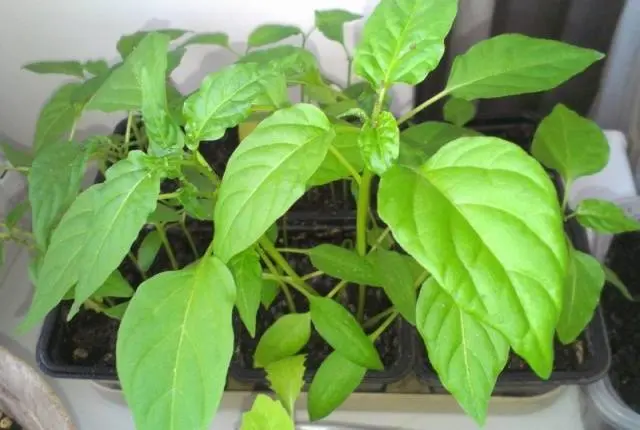
Having decided on the variety, you need to pay attention to the method of planting pepper: on the beds or in the greenhouse.
Growing pepper seedlings largely depends on the method of planting, because the growing season of this crop is long – from three to four and a half months. Therefore, seedlings need to be grown 80-90 days before the transfer of plants to a permanent place – this is approximately mid-February. In any case, seeds for seedlings should be sown no later than mid-March.
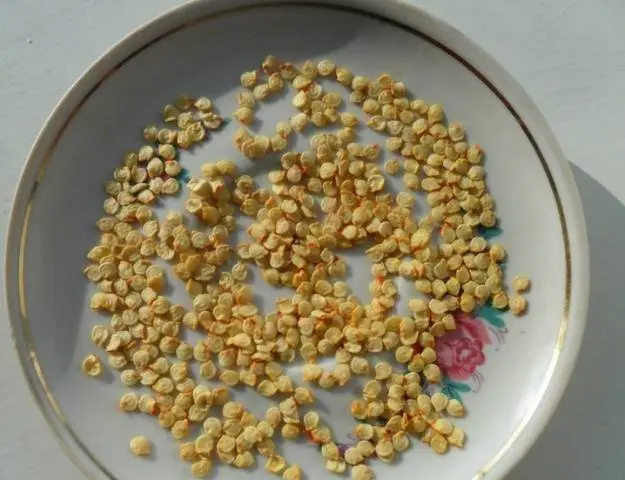

Bulgarian pepper, the cultivation of seedlings of which was carried out in accordance with all the rules, will give a consistently high yield.
Stages of growing seedlings of sweet pepper
All preparatory and landing work can be divided into several stages:
- Soil preparation. For such a culture, soil is considered optimal, consisting of two parts of humus, one part of sand, one part of the earth from the garden and a few tablespoons of wood ash. You can also use purchased universal soil for seedlings. In any case, the soil should be loose and not too acidic.

- Mixed soil must be disinfected. To do this, you can use either the method of calcining the earth in the oven or freezing the substrate on the street.
- Disinfected soil is poured into boxes or pots, holes are made for seeds – about 1,5-2 cm.
- 5-6 hours before planting seeds for seedlings, the earth in boxes and pots is shed with a strong solution of copper sulphate.
- In turn, the seeds also undergo a disinfection procedure – they are placed in a one percent iodine solution for 30 minutes. Another way is water heated to 50 degrees. Seeds are soaked in hot water and closed in a thermos for 4-5 hours (you can overnight).
- After that, the seeds must be wrapped in a damp cloth and placed in a warm place for a couple of days, during which time they should hatch.

- The seeds are now ready to be planted in the ground. They are placed in recesses and sprinkled with earth a little. After that, the earth is carefully watered, making sure not to wash the seeds.
Planting pepper seeds for seedlings is over. Now the boxes or pots need to be covered with polyethylene or glass and put in a warm place where the temperature will be kept at 24-27 degrees. The seedlings do not need sunlight at this stage, on the contrary, let the place for germination be dark.
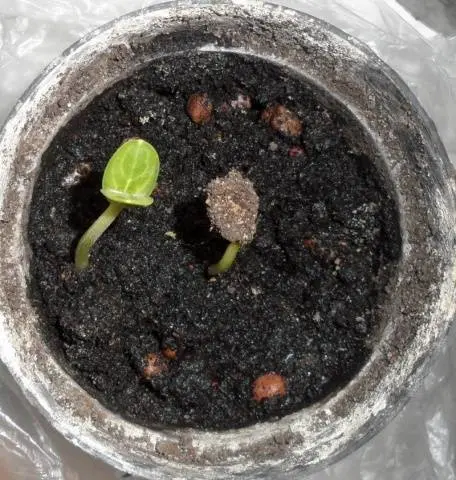
After the appearance of the first sprouts, the film or glass is removed, and the containers with pepper seedlings are placed on window sills or tables, providing them with enough sunlight.
In any case, the seedlings will have to be illuminated, because in the first month after planting, the seedlings need 12-hour lighting – from 7 to 21 hours. To do this, use fluorescent lamps and be sure to control the temperature near the plants.
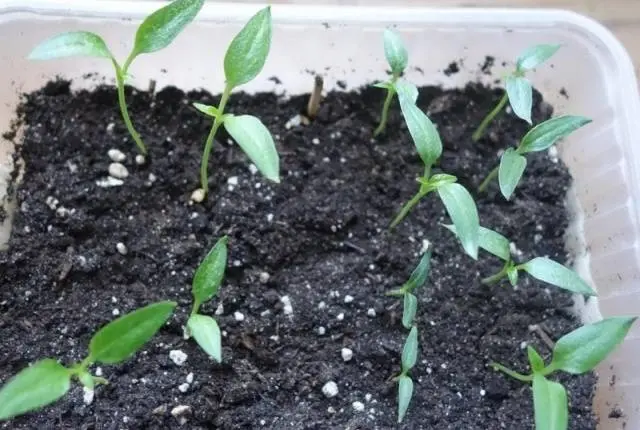
After the appearance of two leaves, the seedlings should be in such temperature conditions: during the day – from 22 to 27 degrees, and at night – from 14 to 16 degrees.
It is very important that the night temperature does not drop further than this level, otherwise the plants will begin to hurt and wither.
Care of pepper seedlings
Since sweet pepper seedlings should be in the house until they reach 25-30 cm in height, do not get stronger, the first buds do not appear on it, the plants will have to be regularly looked after during this time. Moreover, care for pepper seedlings will largely depend on the age of the plants and their condition.
So:
- when the pepper grows a little and two leaves appear on the stems, the time will come for picking seedlings. If the seeds were sown in individual pots, then this stage can be skipped, but for plants from a common box, picking is inevitable. To do this, seedlings are abundantly watered with warm water and allowed to stand for a while. After that, the plants are carefully removed along with an earthy clod in the roots and transferred to individual containers.

- Water the seedlings once or twice a week – the ground should not be excessively wet. To do this, it is recommended to use melted or at least boiled settled water, the temperature of which is about 30 degrees. Cold water adversely affects the seedlings of a heat-loving crop – the plants begin to hurt, rot and die. Sprinkler irrigation is preferable – when the plants are completely irrigated (stems, leaves). For watering small plants, it is convenient to use a spray bottle, then you can switch to a watering can with a diffuser.
- You need to feed the seedlings of a sweet vegetable twice. The first dose of fertilizer is applied at the time of a dive or when two leaves appear on the stems. As a fertilizer at this stage, a solution of potassium, superphosphate and ammonia is used. Fertilizer must be in liquid form, so all components are pre-dissolved in warm water. The second feeding is done two weeks after the first, or when the seedlings have 3-4 leaves. The ingredients are the same, only the dosage of mineral fertilizers should be doubled.
- The earth around the bushes must be loosened, this contributes to the saturation of the soil and pepper roots with oxygen, the best growth of seedlings. Loosening is performed carefully, trying not to damage the delicate root system.
- To maintain a healthy microclimate in a room with sweet pepper seedlings, you need to spray the plants from a spray bottle with warm water and regularly ventilate the room. However, you need to be very careful about drafts – they are detrimental to bell pepper seedlings.

- Peppers grown in boxes and pots need to be prepared for transplanting to a permanent place: in a greenhouse or in open ground. For this, seedlings need to be hardened off. They begin by opening the window for a few minutes on the window, the window sill of which is occupied by pepper. Gradually, cool air baths become longer, the window is kept completely open for several hours. Now you can take the pepper outside or onto the balcony, however, you should avoid wind and drafts that can damage the delicate stems of plants. When the seedlings get a little stronger, they are left in boxes on the street for the night. An important condition is that the air temperature at night should be above 14 degrees.
Transplanting pepper seedlings to a permanent place
Growing sweet pepper seedlings is still half the battle, you need to properly transfer it to the ground and pay enough attention to caring for the plants.
It is necessary to prepare a plot for growing bell pepper at least a year before planting seedlings.
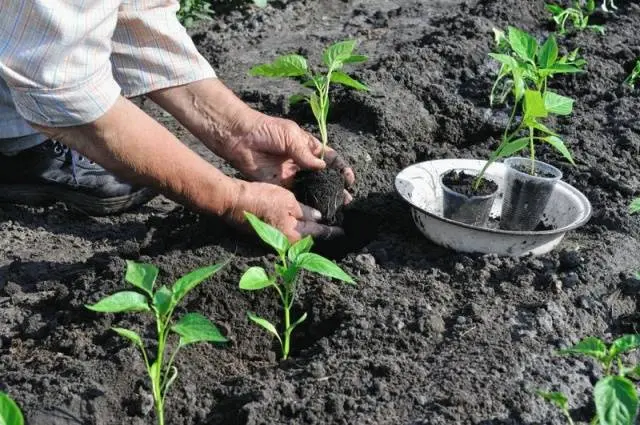
First of all, you need to know what Precursors for sweet pepper should not be his “relatives” from the nightshade family – potatoes, tomatoes, blue ones, physalis. Other crops are considered good predecessors for pepper., especially pumpkin, eggplant, carrots can be distinguished. It is these vegetables that need to be grown in the previous season in the area reserved for sweet peppers.
In the spring (in the year of planting seedlings), the beds are dug up, weeds are removed, professional disinfectants or potassium permanganate solution are used. Ridges are arranged: about 40 cm should be left between the bushes, adjacent rows are made at a distance of 50-60 cm from each other.

Recesses for seedlings should be exactly the depth to which the plant will be buried in the soil. It is best to deepen the plants to the same level at which they grew in cups or boxes.
If the seedlings were grown in peat cups, they are simply buried in the ground to the side of the container.

A handful of ammonium nitrate is first added to the hole, which is mixed with the ground in the hole. Plant the plant and fill the hole half way. Now the seedlings need to be watered. There should be plenty of water – three bushes will need a bucket of water. Water, again, should be warm and settled.
After watering, the hole is completely buried, making sure that the earth does not reach the lower leaves, and they do not touch the ground.
In the first few days after transplanting, pepper seedlings will be lethargic, but this is normal – the plants acclimatize in a new place. There is no need to make a common mistake among gardeners and water the seedlings daily, this will not help it take root, but it will harm, contribute to the decay of the roots.
If the climate in the region is not very warm, in the first weeks after planting, the seedlings must be covered for the night using a film or special agrofibre.
Tips gardeners
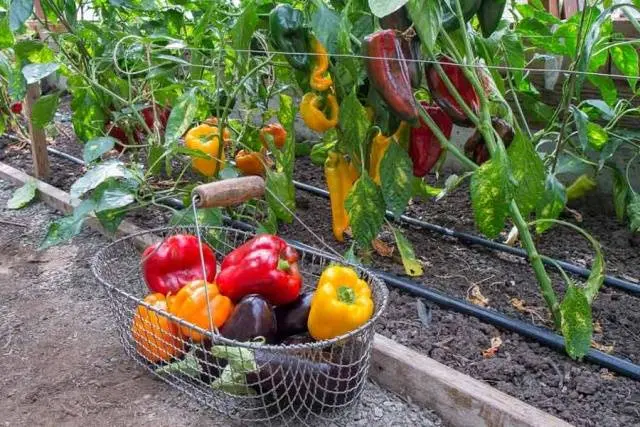
For those who first decided to start growing bell peppers on their own, we can recommend:
- to acquire seeds, albeit not very productive, but resistant varieties of bell pepper. Such varieties and hybrids are much better tolerated by weather “whims”, nutritional deficiencies and moisture. The harvest will be small, but stable.
- For a larger number of ovaries, it is recommended to remove the central inflorescence located at the top of the main stem. This will increase the yield of the bush.
- The culture is grown in two or three stems, if there are more shoots on the bushes, it is better to stepson (remove) them.
- The plant feels very comfortable on mulched beds, the mulch retains moisture well and does not let weeds through. Peat or a ten-centimeter layer of rotted straw is used as a mulching layer.
- To attract pollinating insects to pepper bushes, it is necessary to spray them with sweet water with the addition of bromine during the flowering period. When flowers appear on the bushes, any insecticide treatments should be stopped, because the bees will not pollinate poisonous plants.
- For the whole season, the culture needs to be fertilized about 4-5 times. The best fertilizer for this crop is urea, dissolved in water in a ratio of 1:10.
- The beds need to be regularly weeded and loosened.
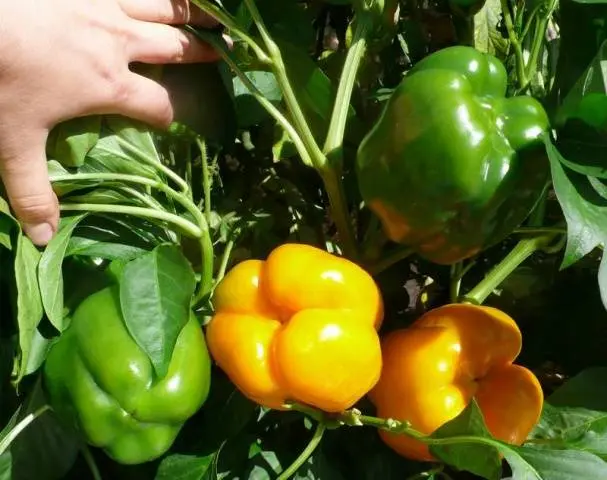
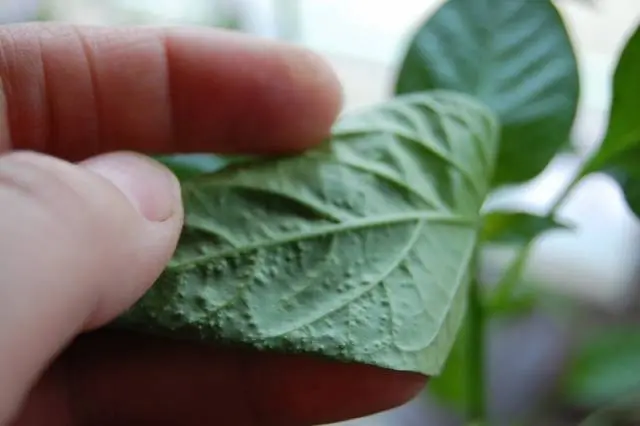
Self-grown bell pepper is undoubtedly tastier than bought in a store or on the market. And most importantly – such vegetables are much healthier and more nutritious. How to properly grow pepper seedlings is described in detail in this article – even a novice gardener will cope with this task.










